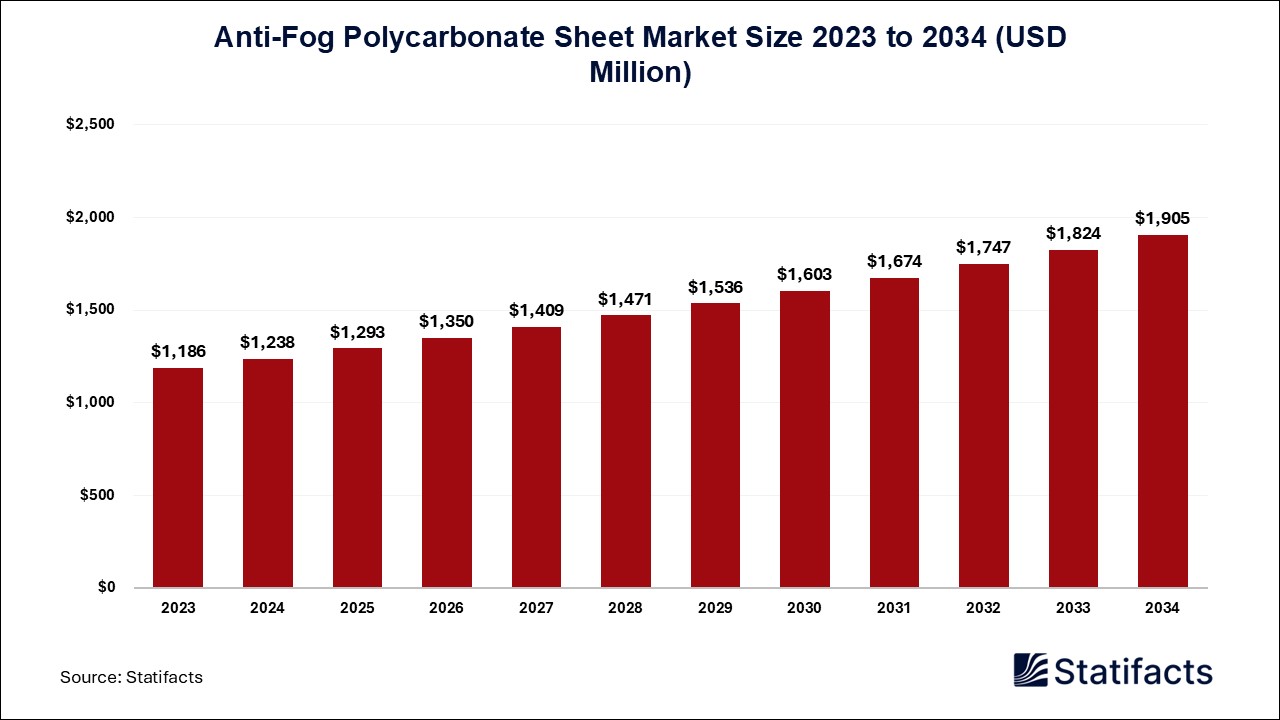
By clicking “Accept All Cookies” you agree to the storing of cookies on your device to enhance site navigation, analyze site usage, and assist in our marketing efforts.
Privacy PolicyStainless Steel Foil Market (By Type: 0.05-0.1 mm and Less Than 0.05mm; By Application: Electronics, Automobile, Medical, and Other; By Region: North America, Europe, Asia Pacific, Latin America, and Middle East & Africa) Industry Size, Share, Growth, Trends 2025 to 2034
The global stainless steel foil market size was valued at USD 1,121 million in 2024, is projected to reach approximately USD 2,205 million by 2034. This growth, driven by increasing demand in automotive, electronics, and industrial applications, is expected at a CAGR of 7%.
| Reports Attributes | Statistics |
| Market Size in 2024 | USD 1,121 Million |
| Market Size in 2025 | USD 1,199 Million |
| Market Size in 2031 | USD 1,800 Million |
| Market Size by 2034 | USD 2,205 Million |
| CAGR 2025 to 2034 | 7% |
| Base Year | 2024 |
| Forecast Period | 2025 to 2034 |
The stainless steel foil market is expanding rapidly as industries continue to seek high-strength and thin-gauge materials for precision applications. Stainless steel foils are valued for their excellent mechanical durability, thermal resistance, and chemical stability, making them ideal for use in batteries, sensors, heat exchangers, fuel cells, and shielding components. The growing adoption of stainless steel foils in electric vehicles (EVs) and consumer electronics, especially in lithium-ion batteries and microelectronic parts, is a key driver of market growth.
However, the market faces restraints such as high production costs associated with precision rolling, limited availability of ultra-thin foil grades, and the need for advanced surface treatment technologies. Volatility in raw material prices, particularly nickel and chromium, can also impact overall cost structures. Despite these challenges, opportunities exist in the development of ultra-thin stainless steel foils for flexible electronics, medical devices, and aerospace components, where miniaturization and performance optimization are key priorities.
The stainless steel foil market is expected to grow more rapidly as artificial intelligence AI and automation become integrated into production, quality control, and materials design. Artificial intelligence enables real-time monitoring of rolling processes, predicting surface defects, and optimizing temperature and pressure parameters for consistent output. Machine learning algorithms can simulate foil performance under stress, aiding in product innovation and reducing waste.
| Regions | Shares (%) |
| North America | 30% |
| Asia Pacific | 35% |
| Europe | 25% |
| LAMEA | 10% |
| Segments | Shares (%) |
| 0.05-0.1 mm | 60% |
| Less Than 0.05mm | 40% |
| Segments | Shares (%) |
| Electronics | 50% |
| Automobile | 25% |
| Medical | 15% |
| Other | 10% |
Published by Saurabh Bidwai
| Type | 2024 | 2025 | 2026 | 2027 | 2028 | 2029 | 2030 | 2031 | 2032 | 2033 | 2034 |
|---|---|---|---|---|---|---|---|---|---|---|---|
| 0.05-0.1 mm | 672.60 | 717.28 | 764.93 | 815.72 | 869.89 | 927.63 | 989.20 | 1,054.85 | 1,124.83 | 1,199.45 | 1279 |
| Less Than 0.05mm | 448.40 | 482.19 | 518.51 | 557.55 | 599.52 | 644.63 | 693.12 | 745.23 | 801.25 | 861.46 | 926.17 |
| Application | 2024 | 2025 | 2026 | 2027 | 2028 | 2029 | 2030 | 2031 | 2032 | 2033 | 2034 |
|---|---|---|---|---|---|---|---|---|---|---|---|
| Electronics | 560.50 | 597.34 | 636.58 | 678.40 | 722.95 | 770.41 | 820.97 | 874.84 | 932.23 | 993.36 | 1,058.48 |
| Automobile | 280.25 | 303.47 | 328.56 | 355.68 | 384.98 | 416.65 | 450.86 | 487.82 | 527.75 | 570.87 | 617.45 |
| Medical | 168.15 | 179.92 | 192.51 | 205.99 | 220.41 | 235.84 | 252.35 | 270.01 | 288.91 | 309.14 | 330.78 |
| Other | 112.10 | 118.75 | 125.78 | 133.21 | 141.06 | 149.36 | 158.14 | 167.41 | 177.20 | 187.54 | 198.47 |
| Region | 2024 | 2025 | 2026 | 2027 | 2028 | 2029 | 2030 | 2031 | 2032 | 2033 | 2034 |
|---|---|---|---|---|---|---|---|---|---|---|---|
| North America | 336.30 | 357.44 | 379.90 | 403.74 | 429.07 | 455.96 | 484.51 | 514.82 | 547.01 | 581.18 | 617.45 |
| Europe | 280.25 | 298.67 | 318.29 | 339.20 | 361.47 | 385.20 | 410.49 | 437.42 | 466.11 | 496.68 | 529.24 |
| Asia Pacific | 392.35 | 423.41 | 456.90 | 493.01 | 531.92 | 573.88 | 619.09 | 667.83 | 720.36 | 776.96 | 837.97 |
| Latin America | 56.05 | 59.97 | 64.17 | 68.66 | 73.47 | 78.61 | 84.12 | 90 | 96.30 | 103.05 | 110.26 |
| Middle East and Africa | 56.05 | 59.97 | 64.17 | 68.66 | 73.47 | 78.61 | 84.12 | 90 | 96.30 | 103.05 | 110.26 |
| Subsegment | 2024 | 2025 | 2026 | 2027 | 2028 | 2029 | 2030 | 2031 | 2032 | 2033 | 2034 |
|---|---|---|---|---|---|---|---|---|---|---|---|
| 0.05-0.1 mm | 672.60 | 717.28 | 764.93 | 815.72 | 869.89 | 927.63 | 989.20 | 1,054.85 | 1,124.83 | 1,199.45 | 1279 |
| Less Than 0.05mm | 448.40 | 482.19 | 518.51 | 557.55 | 599.52 | 644.63 | 693.12 | 745.23 | 801.25 | 861.46 | 926.17 |
| Subsegment | 2024 | 2025 | 2026 | 2027 | 2028 | 2029 | 2030 | 2031 | 2032 | 2033 | 2034 |
|---|---|---|---|---|---|---|---|---|---|---|---|
| Electronics | 560.50 | 597.34 | 636.58 | 678.40 | 722.95 | 770.41 | 820.97 | 874.84 | 932.23 | 993.36 | 1,058.48 |
| Automobile | 280.25 | 303.47 | 328.56 | 355.68 | 384.98 | 416.65 | 450.86 | 487.82 | 527.75 | 570.87 | 617.45 |
| Medical | 168.15 | 179.92 | 192.51 | 205.99 | 220.41 | 235.84 | 252.35 | 270.01 | 288.91 | 309.14 | 330.78 |
| Other | 112.10 | 118.75 | 125.78 | 133.21 | 141.06 | 149.36 | 158.14 | 167.41 | 177.20 | 187.54 | 198.47 |
| Subsegment | 2024 | 2025 | 2026 | 2027 | 2028 | 2029 | 2030 | 2031 | 2032 | 2033 | 2034 |
|---|---|---|---|---|---|---|---|---|---|---|---|
| North America | 336.30 | 357.44 | 379.90 | 403.74 | 429.07 | 455.96 | 484.51 | 514.82 | 547.01 | 581.18 | 617.45 |
| Europe | 280.25 | 298.67 | 318.29 | 339.20 | 361.47 | 385.20 | 410.49 | 437.42 | 466.11 | 496.68 | 529.24 |
| Asia Pacific | 392.35 | 423.41 | 456.90 | 493.01 | 531.92 | 573.88 | 619.09 | 667.83 | 720.36 | 776.96 | 837.97 |
| Latin America | 56.05 | 59.97 | 64.17 | 68.66 | 73.47 | 78.61 | 84.12 | 90 | 96.30 | 103.05 | 110.26 |
| Middle East and Africa | 56.05 | 59.97 | 64.17 | 68.66 | 73.47 | 78.61 | 84.12 | 90 | 96.30 | 103.05 | 110.26 |
To get full access to our Market Insights, you need a Professional Account or a Business Suite.

You will receive an email from our Business Development Manager. Please be sure to check your SPAM/JUNK folder too.

You will receive an email from our Business Development Manager. Please be sure to check your SPAM/JUNK folder too.

Our customers work more efficiently and benefit from


